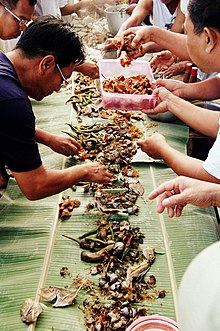Kamayan



| Part of a series on |
| Meals |
|---|
 |
| Meals |
| Components and courses |
| Related concepts |
A boodle fight, in the context of Filipino culture, is the military practice of eating a meal.[1][2][3][4]
Etymology
Sources indicate that the term "boodle" is American military slang for contraband sweets[5] such as cake, candy and ice cream. A "boodle fight" is a party in which boodle fare is served.[6] The term may have been derived from "kit and caboodle"; caboodle is further derived from boodle or booty.[7]
Table manners
A boodle fight is a meal that dispenses with cutlery and dishes.[8] Diners instead practice kamayan, Filipino for "eating with the hands".[9] The food is placed on top of a long banana leaf-lined trestle table and in the true military practice, diners do not sit in chairs but instead stand shoulder to shoulder in a line on both sides of the table.
A senior officer or enlisted personnel then utters the traditional command for the boodle fight to begin:
"Ready on the left,
Ready on the right,
Commence boodle fight!"
Common dishes
There are no set rules about dishes that may be served in a boodle fight. Common dishes include:
- Dry dishes: Fried dried fishes (tuyo, danggit, and pusit)
- Breakfast meats: Tocino, longaniza, and tapa
- Charcoal-grilled meats: Fish, chicken, and pork
- Fruits: Pineapple, mango, and papaya, which are served to balance the salty and oily viands
- Vegetable salads and pickled vegetables: Itlog na maaalat, talong, okra, and atchara
- Deep-fried items: Lumpia, fried fish, and fried chicken
- Rice and noodles
See also
References
- ^ Dumdum Jr., Simeon (10 June 2012). "The boodle fight". Philippine Daily Inquirer. Retrieved 19 March 2008.
- ^ Altheyie. "Boodle fight and the battle of Filipinos – A preview of OFW's life in Canada". Retrieved 16 June 2017.
- ^ Marcaida, Joana Joyce (26 August 2015). "The boodle fight". Retrieved 16 June 2017.[permanent dead link]
- ^ "What is a Boodle Fight? - Ang Sarap". Ang Sarap (A Tagalog word for "It's Delicious"). 2015-05-21. Retrieved 2020-02-10.
- ^ Dolph, Edward Arthur (1942). "Sound off!" Soldier Songs from the Revolution to World War II. Farrar & Rinehart. p. 579.
- ^ Dickson, Paul (2014). War Slang: American Fighting Words & Phrases Since the Civil War. Courier Corporation. p. 132. ISBN 0486797163.
- ^ "Whole kit and kaboodle". World Wide Words. April 10, 1999. Retrieved May 16, 2012.
- ^ Boorman, Charley (2009). Right To The Edge: Sydney To Tokyo By Any Means: The Road to the End of the Earth. Hachette. ISBN 0748113150.
- ^ Lowry, Dave (6 January 2016). "Hand-to-Mouth Combat: Experiencing a Kamayan Dinner at Hiro Asian Kitchen". Retrieved 16 June 2017.
